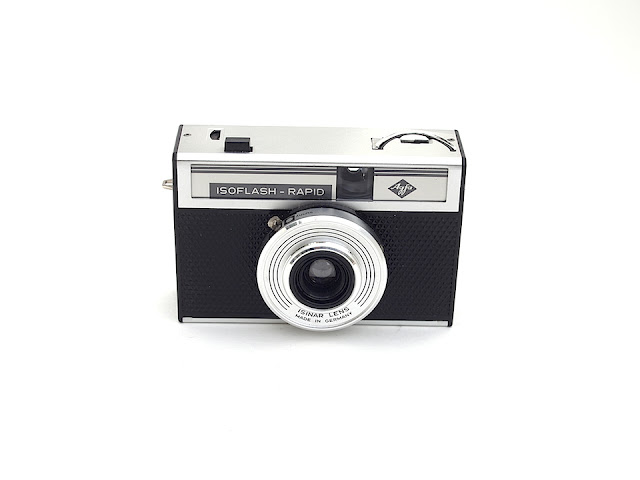After so many Instamatic (126) cameras, here comes Agfa's answer to this easy-load cartridge. It was rather a stopgap answer, Kodak obviously caught Agfa with their pants down. Agfa remembered its Karat cartridge from the mid 30ies, and just added a nose to convey film speed information to the (equiped) cameras. Agfa (re-) launched the system on the market in 1965 together with a series of simple cameras from their camera production plant in Munich. Size and feature set resemble Kodak's Instamatic versions quite a bit, though.
 |
 |
 |
 |
I got my Isoflash-Rapid camera as a complete outfit from an antique store in Astoria, Oregon for just $20. The outfit seems to be unused since 50 years. The roll of film included expired in August 1968, the battery for powering the flash bulbs is probably dead. Besides the comprehensive manual there were "easy load instructions" inside the camera.
Agfa must have known, that real and fool-proof "easy load" was only offered by Kodak's Instamatic cartridge. Obviously, the Rapid film was generally easier to handle than a 135 roll and rewind was not necessary. However, it was more fiddly and there was always the threat that already exposed film could be used a second time. Therefore, Agfa pointed distinctly to the biggest (and almost only) disadvantage of the Kodak cartridge: the insufficient film flatness and the respective loss of sharpness (see picture of the packaging below). It was of no avail. The simple and cheap cameras with their low f-stop lenses from both systems wouldn't really benefit from a film pressure plate. After limited success on the market, Agfa changed their mind already in 1968 and started making film and cameras for the 126 cartridge (named PAK at Agfa). During the early 1970ies they have been quite successful with the Agfamatic series. My very first camera was a Agfamatic 200.
Interestingly, Agfa was able to convice some other manufacturers to produce own cameras for the format. There are even some really nice with some photographic ambitions (eg. Fujica Rapid S2 oder Minolta 24 Rapid). However, no SLR, although this could have made use of the film pressure plate.
I will of course keep the complete outfit in its actual form and don't use the film. However, if I ever find a second Rapid (or SL) cartridge (or an unexposed film roll), I will shoot a roll with the camera. 35 mm film can be easily reloaded, see links below.
I will of course keep the complete outfit in its actual form and don't use the film. However, if I ever find a second Rapid (or SL) cartridge (or an unexposed film roll), I will shoot a roll with the camera. 35 mm film can be easily reloaded, see links below.
| Data Sheet | simple point&shoot camera for Rapid film |
| Lens | Agfa Isinar (single lens meniscus, 40 mm f/8) |
| Shutter | Agfa Parator (1/40 and 1/80 s) |
| Film (format) | 24 x 24 mm (1" x 1") |
| Focussing | Fixfocus |
| Viewfinder | simple viewfinder without frame |
| Flash | AG-1(B) flash bulbs, retractable reflector |
| Film advance | with thumb wheel, no rewind necessary |
| misc. Features | frame counter (backwards), tripod socket |
| Size, Weight | |
| Battery | PX-23 (6V Mercury), only to power flash bulbs |
| Year(s) of Production | 1965-1966 |
| Original Price, Today's Value | US$15 (1965), $10-$20 |
| Links | Camerosity-Blog, Lomography Magazine |




Keine Kommentare:
Kommentar veröffentlichen